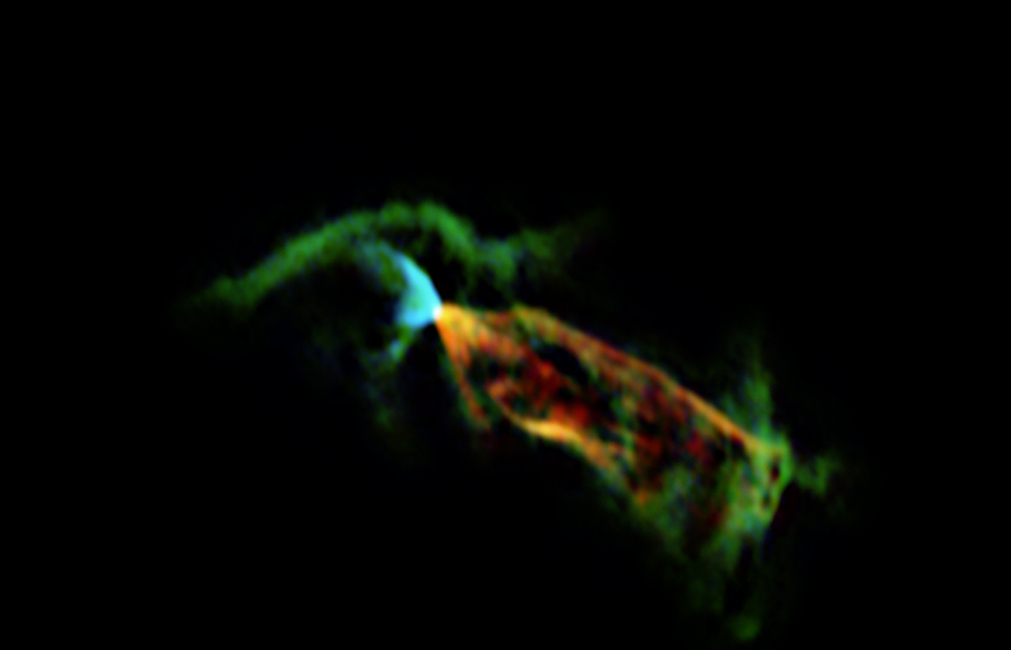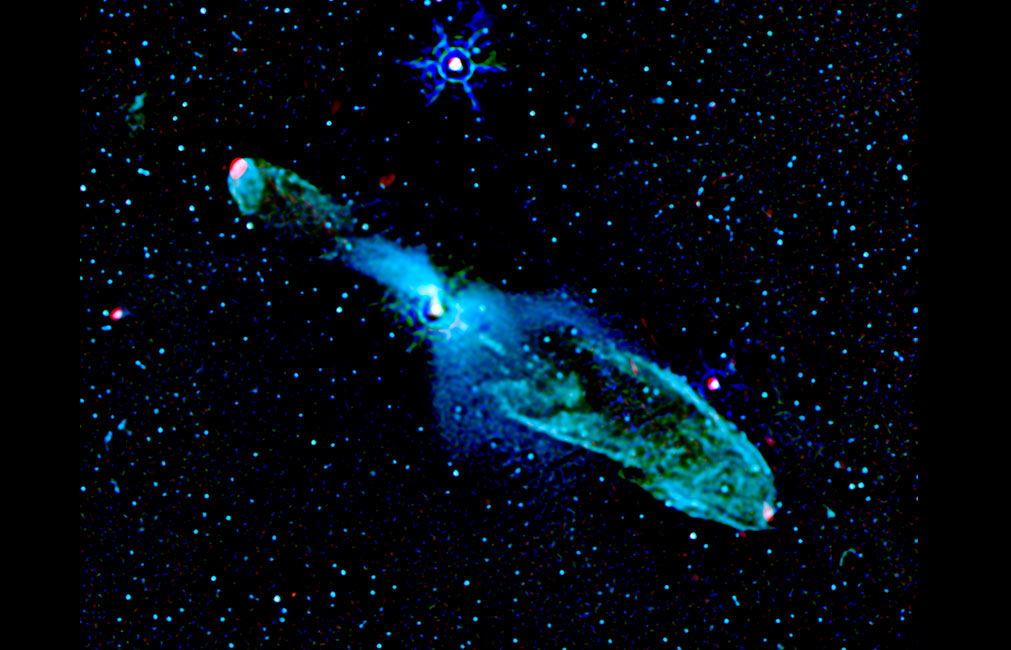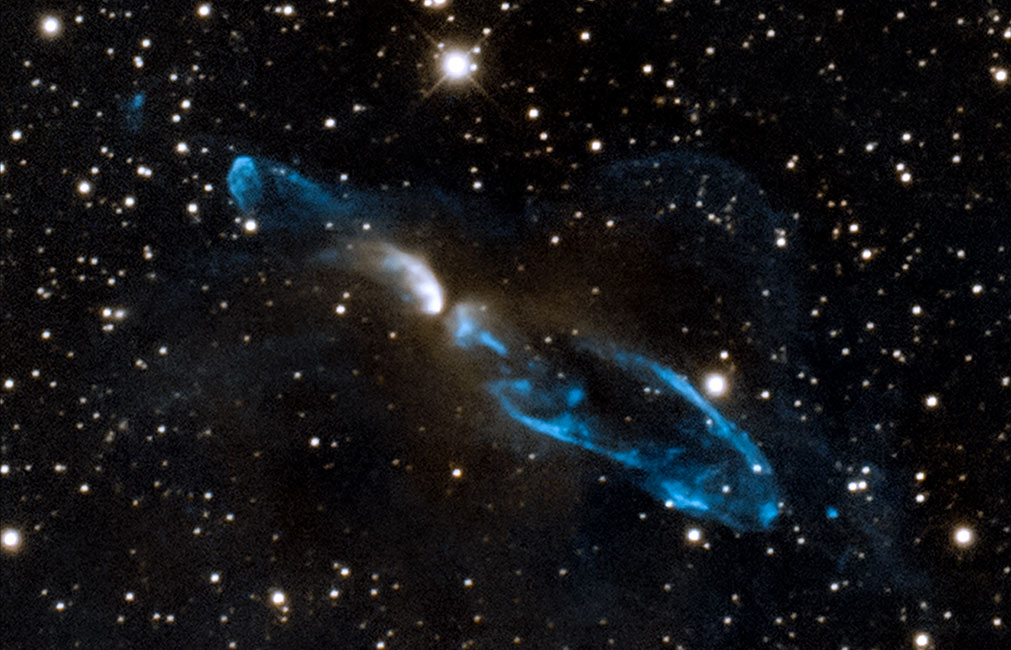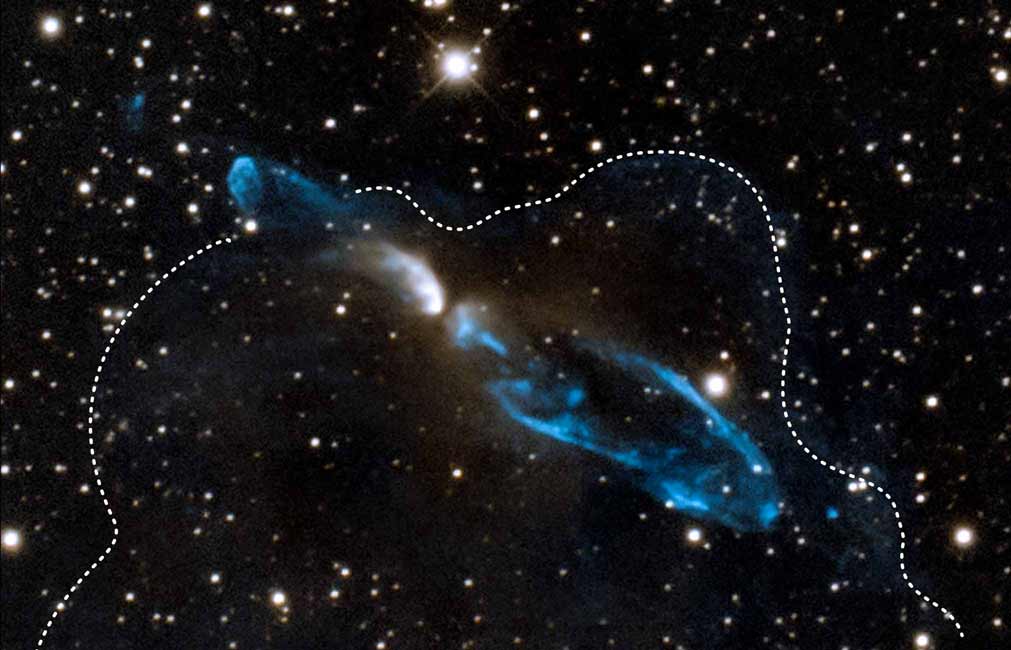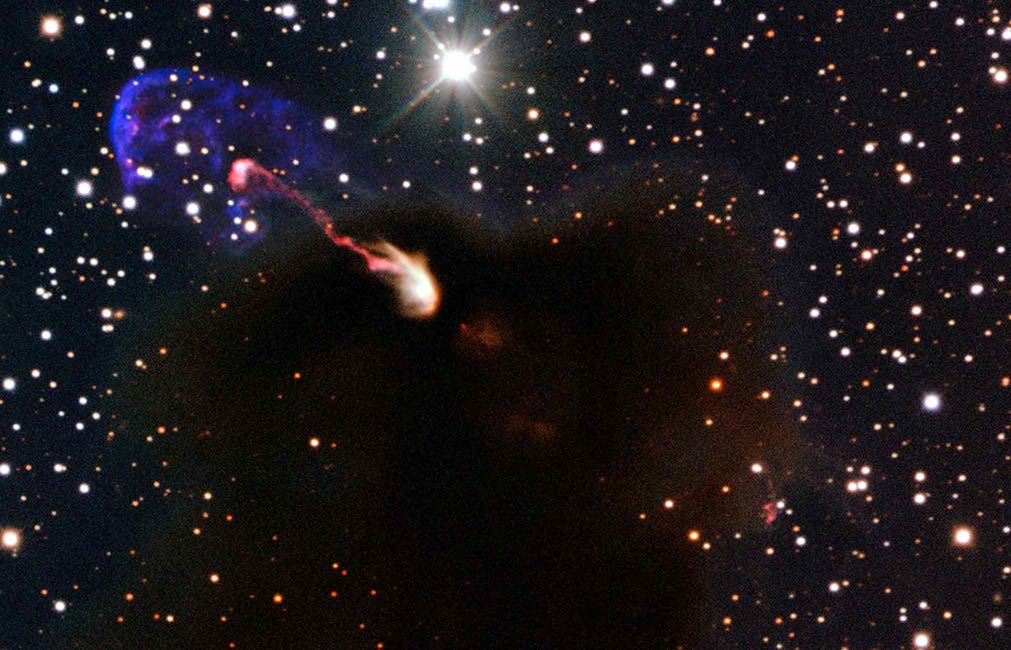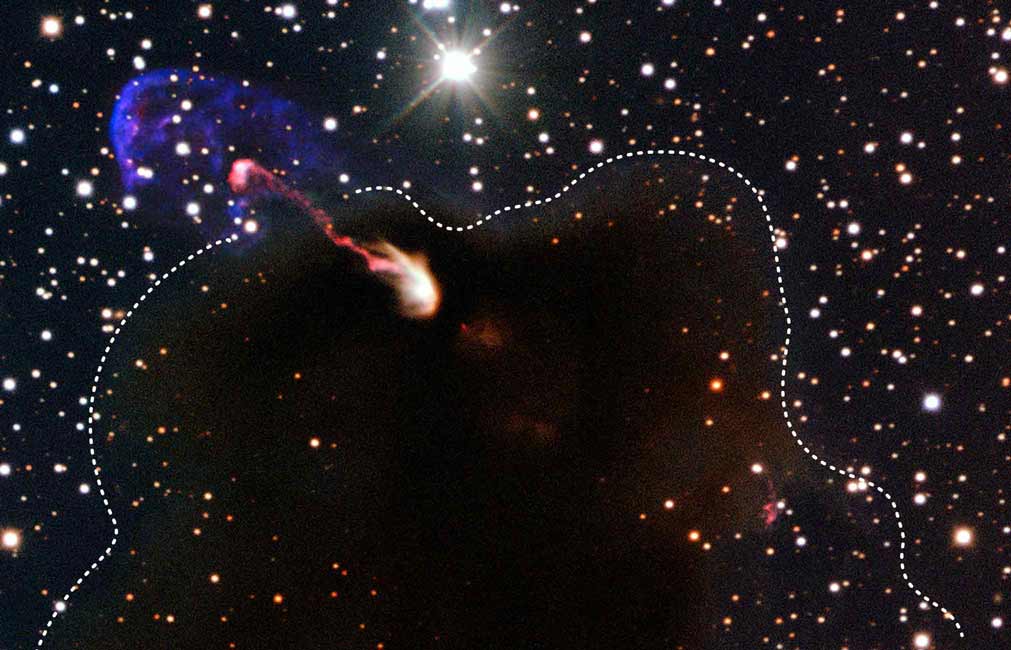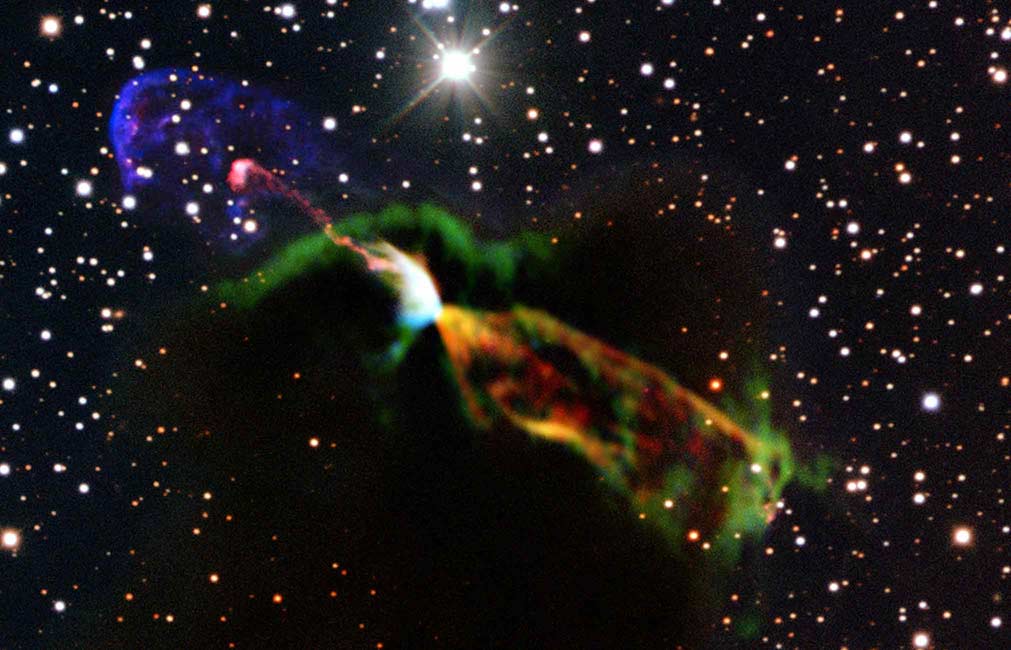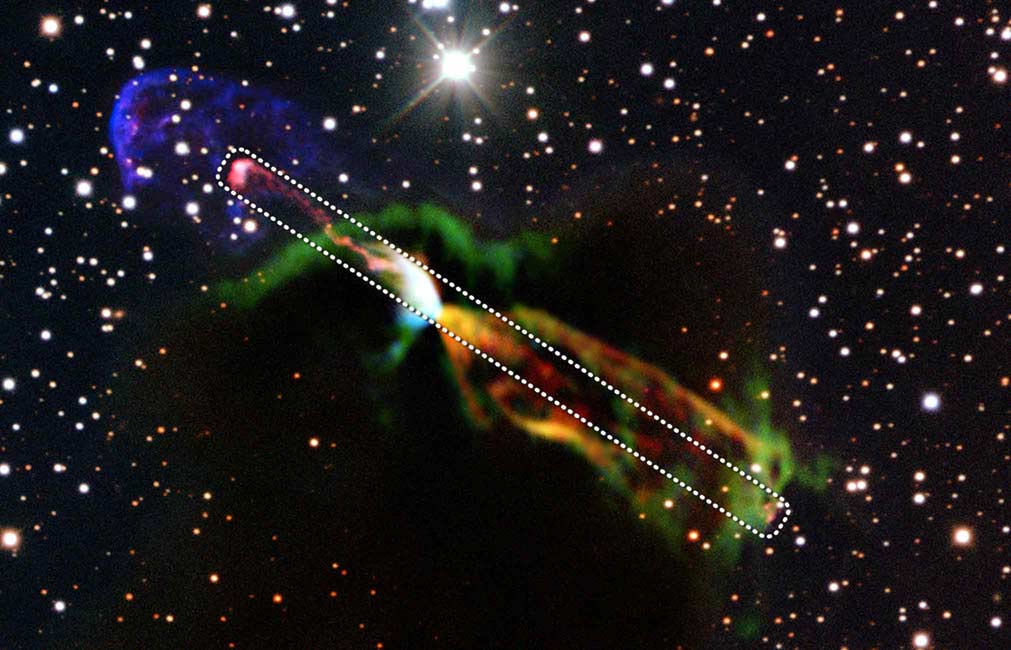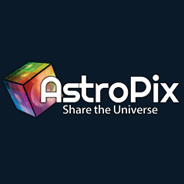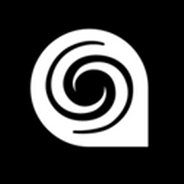Interactive Overview
Slider Interactive: A series of images of Herbig-Haro 46/47 seen in different kinds of light. Below the caption is a horizontal slider bar with five labeled stops and a solid white circle. Dragging the white circle right and left along the slider bar causes elements of the image, labels, and caption to change. The change occurs gradually as one image, along with its associated caption and labels, fades out and the next fades in. A toggle button to the upper right of the image turns the image labels off and on. Some labels are in the form of text with arrows pointing to specific features in the image. Other labels are graphic overlays.
Slider Stops
From left to right, the slider stops are labeled: Radio, Far-infrared, Near-infrared, Visible, and Multi-wavelength.
Summary of Slider Stops
Sliding left to right reveals the following:
- “Radio” stop shows the cavities of Herbig-Haro 46/47 outlined in shades of green, yellow, and blue.
- “Far-infrared” stop shows two blue bubble-like shaped ovals structures in the center and small, blue background stars.
- “Near-infrared” stop shows two blue-white bubble-like structures in the center, hints of the central cloud, and fuzzy white background stars of various sizes scattered across.
- “Visible” stop shows a dense black cloud, a red and blue bulbous region toward the left corner, and fuzzy white background stars of various sizes scattered across.
- “Multi-wavelength” stop shows a composite of all the interactive’s wavelengths combined, showing a view of the dark cloud, the two cavities, and the jets from the young stars. This is the initial image shown when the interactive is loaded.
Stop 1: Radio
Image Description: Radio
Herbig-Haro 46/47 is the colorful object at a 45-degree angle in the center. It looks like a simplified shape of a whale diving deep into the dark ocean. On the upper left is the green and bright blue “tail.” Above the tail-shaped section is a horizontal strand of green as though it is water rippling behind its “body.” The majority of the whale-shaped object is rectangular and outlined in red and orange wisps before it transitions to its apparent “head” and “mouth”—located near the lower right corner—which are green.
Labels: Radio
There are three text labels. The bright blue tail-shaped area on the left is labeled “Gas moving toward Earth.” A dark region within the main body of the “whale” reads “Blown-out cavity.” Further below, a reddish-orange area is labeled “Gas moving away from Earth.”
Caption: Radio
By looking at the coldest gas at the edge of a blown-out cavity, researchers can determine where the jets point.
Stop 2: Far-infrared
Image Description: Far-infrared
This image shows the same patch of sky, now seen in far-infrared light. The overall shape of the object appears like a diving tadpole, but appears at roughly the same size as the “Radio” stop. In the center are two blue bubble-like structures connected by a small white circle. The left bubble is shaped like a long, thin oval. The right bubble is shaped like a slightly thicker oval. The area near the small white circle is fuzzy and cloudy. Transparent pockets throughout the object allow for patches of the background to be seen. Tiny blue dots, which are background stars, are scattered throughout. Near the top center is a large blue dot with a halo and diffraction spikes.
Labels: Far-infrared
There are three text labels. The small white circle that connects the two bubble-like structures is labeled “Central binary stars.” The cloudy region to the right of the small white circle is labeled “Starlight scattered by dust.” The bulbous structure on the right is labeled “Shock-heated gas” toward the bottom.
Caption: Far-infrared
The central stars and the hot, glowing gas of the inner cavity appear in far-infrared light.
Stop 3: Near-infrared
Image Description: Near-infrared
This image shows the same patch of sky, now seen in near-infrared light. The object is more transparent in the center, with its silhouette outlined in wisps of deep blue, appearing like the shape of a diving tadpole, also roughly the same size as the previous images. Toward the object’s center, the color becomes white and light blue. In the background, a faint, light blue line snakes across the image, hinting at the outline of a nebula. Fuzzy white points of various sizes, which are background stars, are scattered throughout. Near the top center is a large white dot with a halo and diffraction spikes.
Labels: Near-infrared
There are three text labels and one graphic overlay. A dashed, wavy white line follows the faint blue outline of the nebula. It is labeled “Cloud of gas and dust.” A small white dot in the bottom center is labeled “Visible background stars.” The large fuzzy white point in the top center is labeled “Foreground star.”
Caption: Near-infrared
Near-infrared light pierces through the dark cloud, but scattered light traces its faint outline.
Stop 4: Visible
Image Description: Visible
This image shows the same patch of sky, now seen in visible light. A puffy, transparent blue area and a narrow red filament is located in the upper left. In the center, where the tadpole-shaped Herbig-Haro 46/47 previously was, is a black cloud blocking objects behind it. The leftmost portion of the left jet is still visible, poking out from the black cloud, while the majority of the jet on the right is blocked. Toward the lower right, there is a light red-orange haze and a small red wisp. Near its edges, the black cloud becomes more transparent. Fuzzy white and yellow points, which are background stars, are seen through the cloud. Further away, the fuzzy points of light become white.
Labels: Visible
There are three text labels and one graphic overlay. A dashed white shaped line, the same outline seen in the prior “Near-infrared” stop, is labeled “Dark cloud of gas and dust.” The red filament in the upper left is labeled “Jet.” The small red wisp in the lower right is labeled “Jet breaking out of molecular cloud.”
Caption: Visible
One jet is largely obscured by the dark cloud of gas and dust, and the other results in a blue shock wave.
Stop 5: Multi-wavelength
Image Description: Multi-wavelength
This is a composite image of all the wavelengths explored in prior stops. A colorful object that appears like a whale is at a 45-degree angle in the center of the image. A narrow red filament emerges from the center of the dark cloud, ending in a puffy, transparent blue area at top left. The upper left edge of the dark cloud is outlined in green. In the center, a u-shaped area, the tail of a whale-shaped object, points to the left and outlines the edge of a cavity in shades of white and green. To the right, the body of the “whale,” a much longer oval cavity is outlined in shades of yellow and red. The black cloud is most opaque toward its center, and more transparent near its edges, allowing some background light through. The points of light near the cloud are shades of orange and the ones farther away are shades of white.
Labels: Multi-wavelength
There are two text labels and one graphic overlay. The white center of the object is labeled, “Hidden central stars.” A white, thin rectangle highlighting the long, thin diagonal area of the two cavities and red filament is labeled “Jets.”
Caption: Multi-wavelength
As two young stars spin, nearby gas flows onto the stars and is launched as opposing jets.
